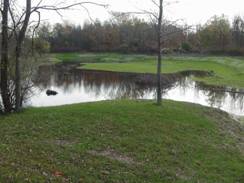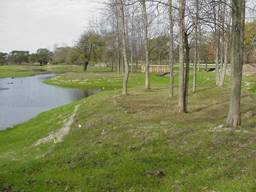Ecology
Biodiversity/Endangered Species | Invasive Species | Living Snow Fence | NYS Pollinator Protection Plan |
Shoreline Stabilization Project |
Wetland Mitigation and Improvements
Biodiversity/Endangered Species
Maintaining the biodiversity of New York State is an important aspect of Environmental Stewardship. New York is fortunate to have a unique environment rich with many different species of animals and plants. As such, the Authority has performed numerous projects to protect species found near and adjacent to the highway.
Some examples of these are as follows:
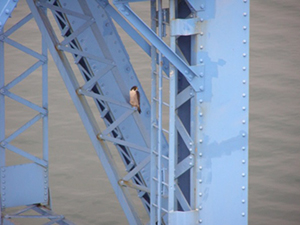
Falcons
The peregrine falcon is an endangered species in New York State. The Thruway Authority supports New York's falcon population by providing nesting boxes on the main trusses of the North and South Grand Island Bridges, both of which cross the Niagara River. A nest box is also installed in the iconic tower of the Governor Mario M. Cuomo Bridge, which crosses the Hudson River 13 miles north of New York City. The activities of the occupants of this box can be viewed by the public anytime on the Falcon webcam, but most activity takes place from late winter through early fall, since the falcons migrate south for the winter.
It is a symbiotic relationship. The bridges provide high vantage points for these birds of prey and create a safe nesting zone away from human interference, while the falcons keep pigeons off the bridges. Keeping the pigeons at bay is beneficial in increasing the life of the bridge as pigeon droppings are harmful to the paint and steel of the structure. Since the program's inception, the number of pigeons nesting on bridges has dramatically decreased.
Authority staff also coordinate with the New York State Department of Environmental Conservation and the New York City Department of Environmental Protection to band falcon chicks and track the livelihood of these endangered birds.
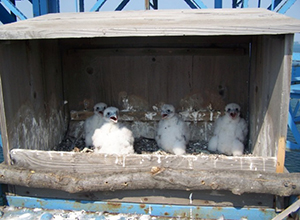
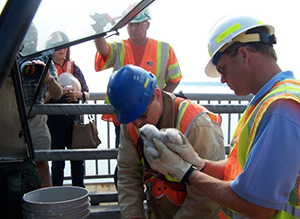
Invasive Species
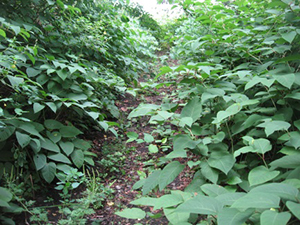 Invasive species are plants, animals, or pathogens that are not native to the ecosystem and their introduction causes (or is likely to cause) harm to the economy, the environment, or human health. Their impact on agriculture, industry, recreation, and our environment is extensive: the United States Department of Agriculture estimates annual economic losses to be in the billions of dollars.
Invasive species are plants, animals, or pathogens that are not native to the ecosystem and their introduction causes (or is likely to cause) harm to the economy, the environment, or human health. Their impact on agriculture, industry, recreation, and our environment is extensive: the United States Department of Agriculture estimates annual economic losses to be in the billions of dollars.
The Authority participates in an inter-agency New York State council to control and combat invasive species. For more information about the Invasive Species Council, please visit the New York State Department of Environmental Conservation at www.dec.ny.gov/animals/6989.html. ![]()
Invasive Plants
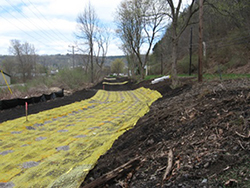 The Thruway Authority (Authority) takes precautions to control the spread of invasive plant species. The following are examples of preventative measures which may be used for different types of projects and activities taking place on the Thruway:
The Thruway Authority (Authority) takes precautions to control the spread of invasive plant species. The following are examples of preventative measures which may be used for different types of projects and activities taking place on the Thruway:
- washing vehicles and equipment before moving them from one site to another so they don’t inadvertently transport invasive species to a new location
- monitoring soil that’s moved or stockpiled for invasive species
- providing special protection to pristine, invasive-free areas, especially wetlands
Additionally, Contractors working on authority projects are directed to take all reasonable precautions to prevent the spread of invasive plant species materials when conducting earthwork activities.
Invasive Insects
With thousands of trees along its right-of-way, the Authority has had the opportunity to collaborate on statewide efforts to study and control the spread of invasive insects that use certain tree species to eat and reproduce.
The Emerald Ash Borer (EAB) is a non-native beetle that feeds on and decimates ash trees. The Authority worked with the New York State Department of Environmental Conservation (NYSDEC) to install traps for the EAB in various locations along the Thruway. These traps helped to detect infestations and map the spread of the EAB.
The Spotted Lantern Fly (SLF) is another invasive insect that poses a serious threat to the state’s trees. The SLF primarily feeds on tree of heaven (Ailanthus altissima), but can feed on other plants, often with devastating effects. The SLF feeds on the sap of trees, leaving them severely stressed and vulnerable to disease and attack from other insects. The Authority is working with NYSDEC to identify and address infestations, and recently removed a grouping of infested tree of heaven near the Sloatsburg Service Area.
Living Snow Fence Program
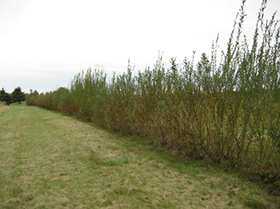 In the winter months, blowing and drifting snow can be a safety hazard for the traveling public. To help alleviate this issue, the Thruway Authority has installed "living snow fences" parallel to the highway. Rows and clusters of willows, lilacs and evergreens have been strategically planted in areas prone to heavy snow fall with blowing and drifting snow. These densely planted configurations trap some of the snow and dissipate blowing snow before it can collect on the highway. Living snow fences require little, if any, maintenance, and provide habitat for birds and pollinators to eat, live, and rest.
In the winter months, blowing and drifting snow can be a safety hazard for the traveling public. To help alleviate this issue, the Thruway Authority has installed "living snow fences" parallel to the highway. Rows and clusters of willows, lilacs and evergreens have been strategically planted in areas prone to heavy snow fall with blowing and drifting snow. These densely planted configurations trap some of the snow and dissipate blowing snow before it can collect on the highway. Living snow fences require little, if any, maintenance, and provide habitat for birds and pollinators to eat, live, and rest.
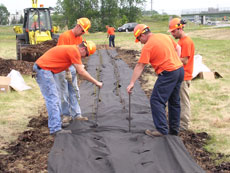 Living snow fences were first installed in 2006, in collaboration with the State University of New York, College of Environmental Science and Forestry, along the I-90 right-of-way at Interchange 18A and Interchange 20 in the Town of Grand Island, Erie County. These densely planted configurations trap some of the snow and dissipate blowing snow before it can collect on the highway.
Living snow fences were first installed in 2006, in collaboration with the State University of New York, College of Environmental Science and Forestry, along the I-90 right-of-way at Interchange 18A and Interchange 20 in the Town of Grand Island, Erie County. These densely planted configurations trap some of the snow and dissipate blowing snow before it can collect on the highway.
Currently, there are thousands of willows and conifers planted along the Thruway right-of-way (ROW) and at various interchanges to help reduce snow drifting across the roadway. These plantings directly result in reduced maintenance costs and greenhouse gas emissions, given the need to plow less frequently in these areas.
During the planting season, our maintenance crews will continue to complete new living snow fence installations across the system and look for additional planting areas along the Thruway right-of-way.
New York State Pollinator Protection Plan
Pollination by bees, butterflies, birds, insects and bats is necessary for our food chain. They play a critical role in enabling plants to make seeds and fruits, including plants in agricultural production. As a result of alarming reduction in both commercially-managed and native pollinator populations, the New York State Pollinator Task Force was formed in 2015. The Task Force developed the New York State Pollinator Protection Plan ![]() and the 2020 Pollinator Protection Plan Update
and the 2020 Pollinator Protection Plan Update ![]() .
.
The Pollinator Protection Plan focuses on four priority areas:
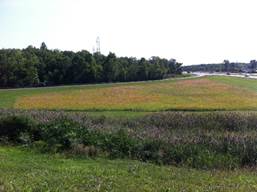
- Development of Best Management Practices for all pollinator stakeholders;
- Habitat enhancement efforts to protect and revive populations of all pollinators;
- Research and monitoring efforts to better understand, prevent and recover from pollinator losses; and,
- Development of an outreach and education program to raise awareness of the importance of pollinators and engage the public as active participants in reversing pollinator decline
The Authority has implemented measures to adopt best practices and enhance pollinator habitat:
Best Practices
- Mowing limits have been established along the Thruway mainline, interchanges and service areas to minimize the cutting of herbaceous vegetation while maintaining safety and addressing public concerns. The reduction of mowing results in the colonization of meadow wildflowers that are beneficial to pollinators. Additional mowing limits are being evaluated along the Thruway system. These areas will be evaluated for the potential to establish perennial wildflowers or other plantings that are beneficial to pollinators.
- Tree trimming and removals are timed to minimize disruption to wildlife, including bats. Dead or decaying trees that do not pose a safety hazard are evaluated for potential colonization of pollinators in cavities within the dead trees.
- UV-light traps have been installed at 10 locations where mosquitoes and other nighttime pests are present. Other locations are being considered for future installations, which will eliminate or reduce the need spray insecticides, which are potentially harmful to pollinators as well as the targeted pests.
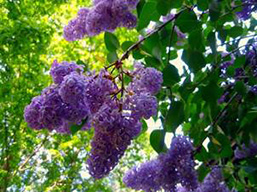
Habitat Enhancement
- Numerous willows and lilacs have been planted in the Thruway's Syracuse Division to serve as living snow fences while also serving as pollinator habitat
- Capital projects are reviewed during design to identify opportunities to substitute standard turf seed mixes with wildflower mixes that will benefit pollinators. Projects are also evaluated to include flowering shrubs and trees, where appropriate.
Shoreline Stabilization Project
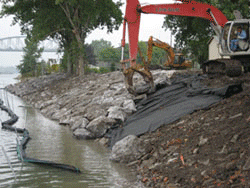
The shoreline of Lake Erie, in the vicinity of the Black Rock Canal, was found to be eroding due to wave action and ice scouring. Stormwater drainage from I-190 in Buffalo also appeared to contribute to the erosion.
To help mitigate and correct the problem, the Thruway Authority, in cooperation with the State University of New York College at Buffalo, installed heavy stone fill to protect 300 feet of the shoreline near stormwater outfall drainage in this location.
Shoreline stabilization will prevent further erosion and sedimentation while promoting the natural restoration of valuable habitat for a variety of warm water fish and aquatic invertebrates.
Wetland Mitigation and Improvements
Wetland Improvements for wildlife along NYS Thruway
There are unique wetland complexes that provide a wealth of flora and fauna diversity along the Thruway corridor. These wetland complexes support many federally and state protected species. Road corridors, adjacent to wetlands, often lead to habitat loss, due to changes in hydrologic conditions and fragmentation.
To better manage hydrologic conditions at one specific wetland complex, the Thruway Authority (NYSTA), in partnership with the New York State Department of Environmental Conservation (NYSDEC), installed a water level control structure in August 2021. For 2022, NYSTA is proposing to remove sediment from two choked culverts beneath the Thruway to accommodate hydrologic and aquatic connectivity at this same location. The work is being guided by research from SUNY-Oswego. The results of SUNY-Oswego’s research will ultimately provide guidelines on how to implement best water-level management practices across the entire wetland complex, in continuing cooperation with NYSTA, NYSDEC and New York State Department of Transportation (NYSDOT).
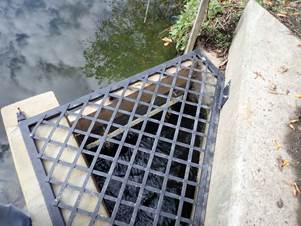
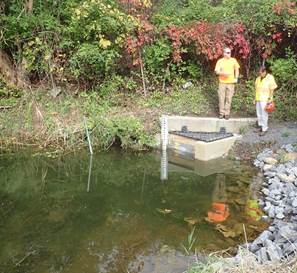
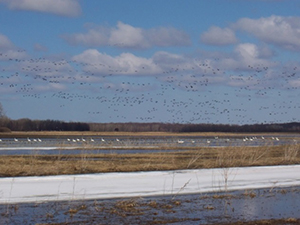 There are times when rehabilitation and maintenance of Thruway Authority (Authority) infrastructure impacts natural wetlands along the highway corridor. As such, the Authority has undertaken unique and innovative wetland mitigation projects. To ensure the projects are successful, the Authority works closely with various Federal and State agencies, including the New York State Department of Environmental Conservation (NYSDEC) and the U.S. Army Corps of Engineers (USACE) on these important endeavors;
There are times when rehabilitation and maintenance of Thruway Authority (Authority) infrastructure impacts natural wetlands along the highway corridor. As such, the Authority has undertaken unique and innovative wetland mitigation projects. To ensure the projects are successful, the Authority works closely with various Federal and State agencies, including the New York State Department of Environmental Conservation (NYSDEC) and the U.S. Army Corps of Engineers (USACE) on these important endeavors;
Montezuma Wetlands Complex Mitigation Project
As part of the 1-90 Reconstruction Project, located just east of Syracuse, the Authority worked with Ducks Unlimited, Inc. (DU), the USACE and NYSDEC to undertake a distinctive mitigation project in the Montezuma Wetlands Complex (MWC). The Authority's mitigation project restored 14 acres of valuable wetlands in the Northern Montezuma Wetlands Complex, located in the Town of Savannah in Wayne County. The site is owned by NYSDEC and is part of their Northern Montezuma Wildlife Management Area. The MWC provides a home for hundreds of wildlife species and functions as a major migration stop for waterfowl and shorebirds in the Atlantic Flyway. Once one of the largest wetland complexes in the Northeast, the MWC supported more than 40,000 acres of contiguous wetland habitat.
Evangola State Park Wetland Mitigation
The Authority, in partnership with the New York State Office of Parks, Recreation and Historic Preservation, completed a noteworthy wetland project at Evangola State Park on Lake Erie, south of Buffalo. As a result of a 2010 road reconstruction project located on nearby I-90, the wetland mitigation project created three new acres of wetlands within the Park to restore the natural landscape. These valuable wetlands provide a variety of environmental benefits as well as educational and recreational opportunities for the public to enjoy. The wildlife habitat will help support the natural food chain, create a stopover for migrating waterfowl, foster a breeding habitat for migratory and nesting bird species, and provide a winter home for amphibians, Additional features of the project include walking trail and interpretive signs. In 2013, the American Council of Engineering Companies of New York selected this project as its Gold Award Winner.
